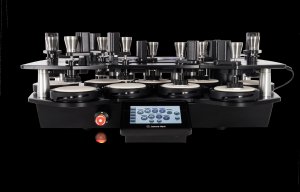
New era in abrasion and pilling testing
Movement which changes from a circle to gradually narrowing ellipses inspired the first version of a classic textile testing instrument.

1st December 2022
Innovation in Textiles
|
Halifax, United Kingdom
“It is often said that necessity is the mother of invention, and wartime tends to bring a focus on necessity,” says Peter Goodwin, technical expert at testing specialist James Heal. “One problem which caused a conundrum during World War 2 was the production of carbon-impregnated fabric, intended to protect against gas attacks.
“As part of his work at the Wool Industries Research Association (WIRA) in the UK, Dr James Graham Martindale was asked to devise a machine to test the wearing properties of this carbon-impregnated fabric. What happened next, was something of a coincidence, but one that would change the course of abrasion testing forever.”
Dr Martindale came across a yarn spinning machine with two opposing motions, realised it was generating a Lissajous figure and subsequently designed a wear tester around the idea.
A Lissajous is a figure created by a movement which changes from a circle to gradually narrowing ellipses until it becomes a Lissajous Figure straight line, from which progressively widening ellipses develop in a diagonally opposite direction before the pattern is repeated. It is named after the French physicist Jules A. Lissajous.
Dr Martindale engaged with Stanley Dilworth, the head of the WIRA workshop, who constructed the first Martindale Abrasion Tester in 1942.
“Thankfully, the carbon-impregnated fabric was never used as the gas attacks ultimately didn’t happen on British soil, so the fabric was used to mask the malodourous nature of the infected wounds of the troops,” Goodwin says. “WIRA did not patent the new device, made no money from its invention, and probably had no idea just how crucial this instrument would become in the future of textiles testing.”
Timeline
In the 1950s, James Heal began to develop its own Martindale with a pre-determined electric counter, which stopped the machine automatically when a pre-set number of rubs was reached.
By 1987 James Heal was still one of only a small number of companies exhibiting a Martindale tester and the early 1990s saw a redesign of the instrument – the six-station Martindale 403, with quick locking clamp rings and a hinged top plate.
At ITMA 1999, the Martindale 406 set a new benchmark in design and functionality with a clear LCD screen and auto restart function.
The next model, the Martindale 864 launched in 2003, offered more choices with four, six or eight stations and an ergonomic top plate design for easy access and optional variable speeds.
In 2010 James Heal took its brand to a whole new level. Working with the Design Council, it rebranded as a company whilst significantly changing the look of the instrument range to sleek black and stainless steel, with distinctive blue LED lighting. Inspired by over 60 years of accumulated knowledge and expertise, the Martindale 900 Series was focused on core values of innovation, quality and precision.
The 1300 Series was launched in 2014 and introduced a hinged top plate to allow easy access to every station from the front to reduce the time to load and unload.
By 2016 the 1600 Series was developed, introducing digital touch-screen technology. Integrated TestWise software provided ease of use and available in multiple language options.
AquAbrasion
Responding to shifts in consumer expectations and trends towards athleisure and performance wear, James Heal developed AquAbrasion – a wet abrasion tester. The first of its kind, it was launched as part of the James Heal Performance Range at ITMA Barcelona in 2019.

AquAbrasion is an accurate and repeatable way of conducting wet abrasion testing, which has proven to be a crucial step in establishing the durability of outdoor and performance wear in relation to real life situations.
“Today, there are many more companies making the Martindale device,” explains James Heal managing director Neil Pryke. “However, James Heal has built on its pedigree and continues to innovate, developing a range of Martindale abrasion and pilling testers with the adaptability to test a wide range of applications, from textiles to wood, and most recently, wet abrasion testing. The AquAbrasion can be used to test the effects of rainwater, perspiration or chlorinated water on textiles, leather and other materials, as well as liquids such as sunscreen or hand sanitiser.

“Since our involvement in the creation of the early models of the Martindale, we have continued to listen to what users and customers need – responding to consumer trends and market demand to develop and improve our flagship instrument. We have sold thousands of Martindale testers over the decades, underpinning our position as a leading supplier and innovator in precision testing instruments. Our Martindale series continues to evolve, keeping our product innovation team very busy. Look out for exciting announcements on further new developments to this classic instrument.”

Business intelligence for the fibre, textiles and apparel industries: technologies, innovations, markets, investments, trade policy, sourcing, strategy...
Find out more